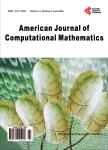Random Crank-Nicolson Scheme for Random Heat Equation in Mean Square Sense
Random Crank-Nicolson Scheme for Random Heat Equation in Mean Square Sense作者机构:Department of Mathematics Faculty of Science Mansoura University Mansoura Egypt
出 版 物:《American Journal of Computational Mathematics》 (美国计算数学期刊(英文))
年 卷 期:2016年第6卷第2期
页 面:66-73页
学科分类:07[理学] 0701[理学-数学] 070101[理学-基础数学]
主 题:Random Partial Differential Equations (RPDEs) Mean Square Sense (m.s) Second Order Random Variable (2r.v.'s) Random Crank-Nicolson Scheme Convergence Consistency Stability
摘 要:The goal of computational science is to develop models that predict phenomena observed in nature. However, these models are often based on parameters that are uncertain. In recent decades, main numerical methods for solving SPDEs have been used such as, finite difference and finite element schemes [1]-[5]. Also, some practical techniques like the method of lines for boundary value problems have been applied to the linear stochastic partial differential equations, and the outcomes of these approaches have been experimented numerically [7]. In [8]-[10], the author discussed mean square convergent finite difference method for solving some random partial differential equations. Random numerical techniques for both ordinary and partial random differential equations are treated in [4] [10]. As regards applications using explicit analytic solutions or numerical methods, a few results may be found in [5] [6] [11]. This article focuses on solving random heat equation by using Crank-Nicol- son technique under mean square sense and it is organized as follows. In Section 2, the mean square calculus preliminaries that will be required throughout the paper are presented. In Section 3, the Crank-Nicolson scheme for solving the random heat equation is presented. In Section 4, some case studies are showed. Short conclusions are cleared in the end section.



